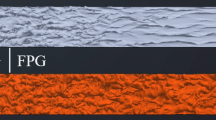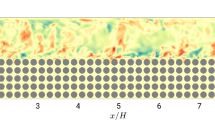Abstract
The work discusses fundamental aspects of local solutions and asymptotic matching for transpired turbulent boundary layers with support from DNS simulations and previous analytical formulations validated through experimental data. The DNS data are obtained for porous wall pipe flows, for six different transpiration rates (\(v_w/u_\tau = -\,0.063, -\,0.015\), 0.0, 0.015, 0.053 and 0.095) and moderate Reynolds number (\(\mathrm{Re}_{{\tau }}\) = \(u_\tau D/\nu\)), varying from 340 to 460. In terms of the classical global parameters, the Reynolds number (Re = \(UD/\nu\)) range is 5700–10,500. Wall fluid injection or suction is applied continuously and throughout the axial pipe direction, meaning that the flow accelerates through the computational domain. The impossibility of application of cyclic boundary conditions at the inlet and outlet pipe sections is circumvented with the use of convective conditions. The work particularly discusses similarity of the mean and turbulent quantities in terms of the transpiration parameters \(u/u_\tau\) (\(u_\tau\) = friction velocity), \((u_\tau y)/\nu\), \((v_w u)/u_\tau ^2\) (\(v_w\) = injection velocity), \((v_w y)/\nu\), \((u_\tau ^2 y)/(\nu w^*)\) (with \(w^* = 2.3 u_\tau (1 + 9 v_w^+)\), \(v_w^+\) = \(v_w/u_\tau\)), \(u/w^*\), \(u/u_c\) [with \(u_c\) defined as in Guimaraes et al. (Int J Heat Fluid Flow 78:108436, 2019)] and \({yu_c}/{\nu }\). A discussion based on the arguments of Millikan and on the matched asymptotic expansions method shows that bilogarithmic mean velocity solutions match in a common domain provided certain asymptotic identities are satisfied. A parametrization scheme based on the classical similarity velocity, the friction velocity, is developed to correlated the points of maximum value for the elements of the Reynolds stress tensor with the transpiration rate.













Similar content being viewed by others
References
Olson RM, Eckert ERG (1966) Experimental studies of turbulent flow in a porous circular tube with uniform fluid injection through the tube wall. J Appl Mech 33:7–17
Bandeira FJS, Gonçalves GFN, Loureiro JBR, Silva Freire AP (2017) Turbulence and bubble break up in slug flow with wall injection. Flow Turbul Combust 98:923–945
Guimaraes MC, Cruz DOA, Silva Freire AP (2019) Similarity laws for transpired turbulent flows subjected to pressure gradients, separation and wall heat transfer. Int J Heat Fluid Flow 78:108436
Cruz DOA, Silva Freire AP (1998) On single limits and the asymptotic behaviour of separating turbulent boundary layers. Int J Heat Mass Transf 41(14):2097–2111
Cruz DOA, Silva Freire AP (2002) Note on a thermal law of the wall for separating and recirculating flows. Int J Heat Mass Transf 45(7):1459–1465
Loureiro JBR, Silva Freire AP (2011) Scaling of turbulent separating flows. Int J Eng Sci 49(5):397–410
Prandtl L (1925) Über die ausgebildete Turbulenz. ZAMM 5:136–139
von Kármán Th (1930) Mechanische aehnlichkeit und turbulenz. In: Proceedings of third international congress for applied mechanics, Stockholm
Millikan CB (1939) A critical discussion of turbulent flow in channels and tubes. In: Proceedings of 5th international congress on applied mechanics. Wiley, New York, pp 386–392
Goldstein S (1948) On laminar boundary-layer flow near a position of separation. Q J Mech Appl Math 1(1):43–69
Stratford BS (1959) The prediction of separation of the turbulent boundary layer. J Fluid Mech 5(1):1–16
Tennekes H (1964) Similarity laws for turbulent boundary layers with suction or injection. Report VTH-119, Technological University Delft, Department of Aeronautical Engineering
Yajnik KS (1970) Asymptotic theory of turbulent shear flow. J Fluid Mech 42:411–427
Mellor GL (1970) The large Reynolds number, asymptotic theory of turbulent boundary layers. Int J Eng Sci 10:851–873
Avsarkisov V, Oberlack M, Hoyas S (2014) New scaling laws for turbulent Poiseuille flow with wall transpiration. J Fluid Mech 746:99–122
Sumitani Y, Kasagi N (1995) Direct numerical simulation of turbulent transport with uniform wall injection and suction. AIAA J 33(7):1220–1228
Nikitin NV, Pavel’ev AA (1998) Turbulent flow in a channel with permeable walls. Direct numerical simulation and results of three-parameter model. Fluid Dyn 33(6):826–832
Ferziger JH, Peric M (2002) Computational methods for fluid dynamics. Springer
Kametani Y, Fukagata K (2011) Direct numerical simulation of spatially develo** turbulent boundary layers with uniform blowing or suction. J Fluid Mech 681:154–172
Kaplun S (1967) Fluid mechanics and singular perturbations. Academic Press, New York
Lagerstrom PA (1968) Matched asymptotic expansions. Springer Verlag, Heidelberg
Fraenkel LE (1969) On the method of matched asymptotic expansions. Part I: a matching principle. Math Proc Camb Philos Soc 65:209–231
Eckhaus W (1973) Asymptotic analysis of singular perturbations. North-Holland, Amsterdam
Eckhaus W (1994) Fundamental concepts of matching. SIAM Rev 36:431–439
Mauss J (1979) On matching principles. In: Verhulst F (ed) Asymptotic analysis. Lecture notes in mathematics, vol 711. Springer, Berlin, pp 1–8
Clauser FH (1954) Turbulent boundary layers in adverse pressure gradients. JAS 21:91–108
Clauser FH (1965) The turbulent boundary layer. Adv Appl Mech 4:1–55
Coles D (1956) The law of the wake in turbulent boundary layers. J Fluid Mech 1:191–226
Fritsch W (1928) Einfluss der wandrauhigkeit auf die turbulente geschwindigkeitsverteilung in rinnen. Zeitschrift für angewandte Mathematik und Mechanik ZaMM 8:199–216
Bush WB, Fendell FE (1972) Asymptotic analysis of turbulent channel and boundary layer flows. J Fluid Mech 56:657–681
Afzal N (1973) A higher order theory for compressible turbulent boundary layers at moderately large Reynolds number. J Fluid Mech 57:1–27
Melnik RE, Grossman B (1974) Analysis of the interaction of a weak normal shock wave with a turbulent boundary layer. AIAA Paper, No 74-598
Adamson TC, Feo A (1975) Interaction between a shock wave and a turbulent boundary layer at transonic speeds. SIAM J Appl Math 29:121–145
Liou MS, Adamson TC (1980) Interaction between a normal shock wave and a turbulent boundary layer at high transonic speeds. Part II. Wall shear stress Zeitschrift für angewandte Mathematik und Physik ZaMP 31:227–246
Silva Freire AP (1989) On the matching conditions for a two-deck compressible turbulent boundary layer model. Zeitschrift für angewandte Mathematik und Mechanik ZaMM 69:100–104
Silva Freire AP (1988) An asymptotic solution for transpired incompressible turbulent boundary layers. Int J Heat Mass Transf 31(5):1011–1021
Silva Freire AP (1988b) An extension of the transpired skin-friction equation to compressible turbulent boundary layers. Int J Heat Mass Transf 31(11):2395–2398
Faraco-Medeiros MA, Silva Freire AP (1992) The transfer of heat in turbulent boundary layers with injection or suction: universal laws and Stanton number equations. Int J Heat Mass Transf 35(4):991–995
Silva Freire AP (1988) An asymptotic approach for shock-wave/transpired turbulent boundary layer interactions. Zeitschrift für angewandte Mathematik und Physik ZaMP 39(4):478–503
Silva Freire AP (1989) A detailed review of a solution procedure for shock-wave transpired turbulent boundary layer interaction problems. J Braz Soc Mech Sci (RBCM) 11:211–246
Avelino MR, Su J, Silva Freire AP (1999) An analytical near wall solution for the κ–\(\epsilon\) model for transpired boundary layer flows. Int J Heat Mass Transf 42(16):3085–3096
Silva Freire AP, Cruz DOA, Pellegrini CC (1995) Velocity and temperature distributions in compressible turbulent boundary layers with heat and mass transfer. Int J Heat Mass Transf 38(13):2507–2515
Sychev VV, Sychev VV (1987) On turbulent boundary layer structure. J Appl Math Mech 51:462–467
Neish A, Smith FT (1988) The turbulent boundary layer and wake of an aligned flat plate. J Eng Math 22:15–42
Kay JM (1948) Boundary-layer flow along a flat plate with uniform suction. Reports and Memoranda 2628, Aeronautical Research Council
Clarke JH, Menkes HR, Libby PA (1955) A provisional analysis of turbulent boundary layers with injection. J Aeronaut Sci 22(4):255–260
Mickley HS, Davis RS (1957) Momentum transfer for flow over a flat plate with blowing. Technical Notes 4017, National Advisory Committee for Aeronautics
Black TJ, Sarnecki AJ (1958) The turbulent boundary layer with suction or injection. Reports and Memoranda 3387, Aeronautical Research Council
Stevenson TN (1963) A law of the wall for turbulent boundary layers with suction or injection. Report 166, College of Aeronautics, Cranfield ,England
Coles D (1972) A survey of data for turbulent boundary layers with mass transfer. In: Proceedings of the AGARD conference on turbulent shear flows, London, AGARD-CP 93
Andersen PS, Kays WM, Moffat RJ (1972) The turbulent boundary layer on a porous plate: an experimental study of the fluid mechanics for adverse free-stream pressure gradients. In: Report HMT-15, Stanford University
van Dyke M (1975) Perturbation methods in fluid mechanics. Parabolic Press, Stanford
Silva Freire AP (2016) The persistence of logarithmic solutions in turbulent boundary layer systems. J Braz Soc Mech Sci Eng 38:1359–1399
Avsarkisov VS, Oberlack M, Hoyas S, Khujadze G (2014) New scaling laws for turbulent Poiseuille flow with wall transpiration. J Fluid Mech 746:99–122
Ferziger JH, Peric M (2002) Computational methods for fluid dynamics. Springer
Pearson RA (1974) Consistent boundary conditions for numerical models of systems that admit dispersive waves. J Atmos Sci 31(6):1481–1489
Wu Z, Laurence D, Afgan I (2017) Direct numerical simulation of a low momentum round jet in channel crossflow. Nucl Eng Des 313:273–284
Villiers E (2006) The potential of large Eddy simulation for the modeling of wall bounded flows. PhD thesis, Imperial College of Science, Technology and Medicine
Fukagata K, Kasagi N (2002) Highly energy-conservative finite difference method for the cylindrical coordinate system. J Comput Phys 181:478–498
Schlichting H (1979) Boundary-layer theory. McGraw-Hill, New York
Favre A, Dumas R, Verollet E, Coantic M (1966) Couche limite turbulent sur paroi poreusse avec transpiration. J Mecanique 5:3–28
Simpson RL (1967) The turbulent boundary layer on a porous plate: an experimental study of the fluid dynamics with injection and suction. PhD thesis, Stanford University
Kametani Y, Fukagata K, Örlu R, Schlatter P (2015) Effect of uniform blowing/suction in a turbulent boundary layer at moderate Reynolds number. Int J Heat Fluid Flow 55:132–142
Hanjalić K (1970) Two-dimensional asymmetric turbulent flow in ducts. PhD thesis, Imperial College of Science, Technology and Medicine
Hanjalić K, Launder BE (1972) A Reynolds stress model of turbulence and its application to thin shear flows. J Fluid Mech 52:609–638
Cantwell BJ (1981) Organized motion in turbulent flow. Ann Rev Fluid Mech 13:457–515
Acknowledgements
APSF is grateful to the Brazilian National Research Council (CNPq) for the award of a Research Fellowship (No 307232/2019-0). The work has been financially supported by FAPERJ through Grant E-26/010.001275/2016 (Pronex Núcleo de Excelência em Turbulência). The authors are grateful to the administrators of NACAD (Núcleo Avançado de Computação de Alto Desempenho da COPPE/UFRJ) for access to the Lobo Carneiro Computer. All of the DNS data were originally presented in the MSc Thesis of MJR. The data can be directly accessed at the address shown below or requested from the first author of the paper. The WWW address for access to MJR’s thesis is: https://w1files.solucaoatrio.net.br/atrio/ufrj-pem_upl//THESIS/1876/pemufrj2017mscmilenajordaorempto_20200206153133411.pdf
Author information
Authors and Affiliations
Corresponding author
Additional information
Technical Editor: Erick Franklin.
Publisher's Note
Springer Nature remains neutral with regard to jurisdictional claims in published maps and institutional affiliations.
Rights and permissions
Springer Nature or its licensor holds exclusive rights to this article under a publishing agreement with the author(s) or other rightsholder(s); author self-archiving of the accepted manuscript version of this article is solely governed by the terms of such publishing agreement and applicable law.
About this article
Cite this article
Rempto, M.J., Freire, A.P.S. Asymptotic matching arguments and DNS for transpired turbulent flows. J Braz. Soc. Mech. Sci. Eng. 44, 415 (2022). https://doi.org/10.1007/s40430-022-03720-7
Received:
Accepted:
Published:
DOI: https://doi.org/10.1007/s40430-022-03720-7




